-
Are you a Tarantula hobbyist? If so, we invite you to join our community! Once you join you'll be able to post messages, upload pictures of your pets and enclosures and chat with other Tarantula enthusiasts. Sign up today!
You are using an out of date browser. It may not display this or other websites correctly.
You should upgrade or use an alternative browser.
You should upgrade or use an alternative browser.
solifugae
-

Eremorhax magnellus
similar to magnus but with darker fuscous markings and tergites- MBullock
- Media item
- camel spider eremobatidae eremorhax magnellus solifugae windscorpion
- Comments: 0
- Album: Other arachnida
-

Solifugae can double-clutch!
Apparently, solifugae can lay more than one clutch! One of my female eremobates Sp. survived one clutch and is developing more eggs again. As i work with them more, and more, i'm figuring out that the most people studying them dont seem to be making many behavioral studies and are more...- MBullock
- Thread
- breeding brood eremobates solifugae
- Replies: 1
- Forum: Invertebrate Pet Talk
-
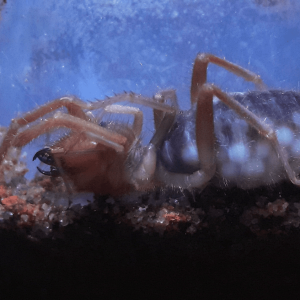
Eremobates SP
same species as previous female, heavily gravid and soon to oviposit. Ive learned more by watching these animals behave in nature than reading the entire solifuge revision page. Being a naturalist will actually teach you more than any amount of Nuclear morphometric analysis EVER will. ;)- MBullock
- Media item
- eremobates eremobatidae gravid solifugae windscorpion
- Comments: 0
- Album: Other arachnida
-
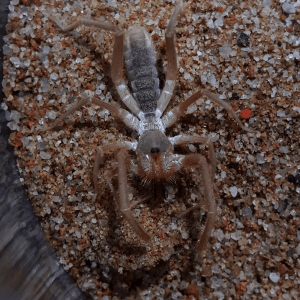
Eremobates SP
The male counterpart of said un-described species of Eremobates. Extremely nervous and seems to have even better eyesight than other eremobatidae. aggressive compared to other eremobates and will bite with little provocation.- MBullock
- Media item
- eremobates eremobatidae solifugae windscorpion
- Comments: 0
- Album: Other arachnida
-

Eremobates SP
Undescribed 2" female eremobates species, gravid. neither kastoni nor vicinus. The region it came from has largely been ignored by people studying solifugae. overwinters as a late-instar nymph, then emerges again in spring when temps are high enough. mature males and females are gone in july.- MBullock
- Media item
- eremobates eremobatidae solifugae windscorpion
- Comments: 0
- Album: Other arachnida
-

Ammotrechula catalinae
A striking ammotrechid (slant-faced) solifugide native to the catalina mountains of arizona.- MBullock
- Media item
- ammotrechidae ammotrechula camel spider solifugae
- Comments: 7
- Album: Other arachnida
-

Eremorhax joshui
Mature male. Eremorhax are extremely sexually dimorphic, with females having very short limbs and a massive abdomen, similar to the old-world genus Rhagodes. They also share the unusual ant-killing behavior as well. presumably sequestering peptides for defense or digestive aid.- MBullock
- Media item
- camel spider eremobatidae eremorhax solifugae windscorpion
- Comments: 0
- Album: Other arachnida
-
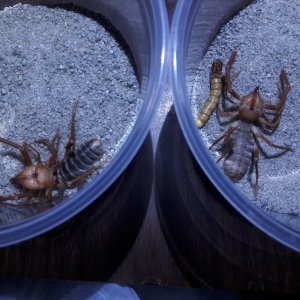
eremocosta calexicensis vs titania
Calexicensis on the left, Titania on the right. the two apparently hybridize and create fertile offspring, as well. it may be that one is actually a subspecies of the other.- MBullock
- Media item
- eremobatidae eremocosta solifugae windscorpion
- Comments: 0
- Album: Other arachnida
-

Unknown eremobatid nymph
hard to say what it is. could be chanbria, could be eremorhax. whatever the case, it's adorable, lol.- MBullock
- Media item
- eremobatidae solifugae
- Comments: 0
- Album: Other arachnida
-

Eremocosta titania mature female
example of size.- MBullock
- Media item
- eremobatidae eremocosta solifugae
- Comments: 0
- Album: Other arachnida
-

Titan Windscorpion
She has survived her molt. I must now obtain a male- MBullock
- Media item
- eremocosta molt solifugae
- Comments: 1
- Album: Other arachnida
-
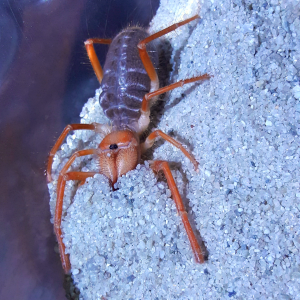
Eremocosta titania
penultimate female bulldozing- MBullock
- Media item
- eremocosta solifugae
- Comments: 0
- Album: Other arachnida
-

Chanbria regalis resting state
solifugae have an unusual way to molt- they basically have a pupal stage before every molt, and become immobile, only capable of moving the abdomen when disturbed. this resting state is often confused for a dead or dying solifuge- MBullock
- Media item
- solifugae
- Comments: 0
- Album: Other arachnida
-
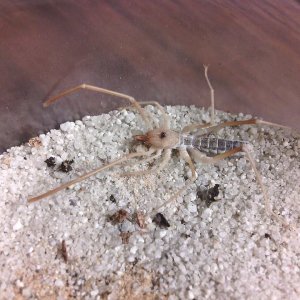
-
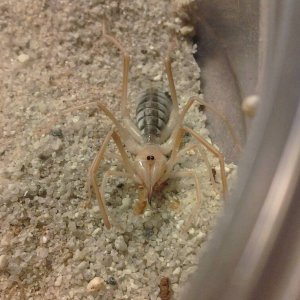
Chanbria regalis
a highly unusual ultra-psammophile only found around shifting transient dune fields. they run around making brief pauses every 6-12" digging to snatch small fossorial insects and spiders causing a peculiar trail of small depressions in the sand, sometimes mistaken for rabbit tracks.- MBullock
- Media item
- solifugae
- Comments: 3
- Album: Other arachnida
-

eremobates pallidus
A beautiful ivory-colored scorpion endemic to southern california- MBullock
- Media item
- solifugae
- Comments: 1
- Album: Other arachnida
-
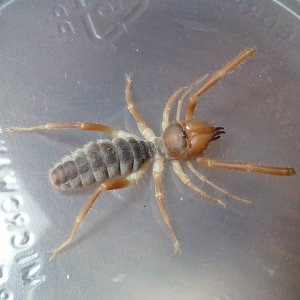
Eremobates kastoni
A less-common species that reaches a larger size than vicinus, syntopic with the aforementioned species.- MBullock
- Media item
- solifugae
- Comments: 0
- Album: Other arachnida
-

Eremobates vicinus
A small and common solifuge that never exceeds 1.5" Abundant throughout southern california- MBullock
- Media item
- solifugae
- Comments: 0
- Album: Other arachnida
-

-

Eremocosta titania
Eremocosta are the new world's largest Solifugae. These solifugae will ascend into paloverdes and search for sleeping prey, they probably target urosaurus primarily as those sleep in trees and cannot defend themselves.- MBullock
- Media item
- solifugae
- Comments: 0
- Album: Other arachnida